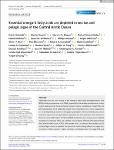Essential omega‐3 fatty acids are depleted in sea ice and pelagic algae of the Central Arctic Ocean
| dc.contributor.author | Schmidt, K | |
| dc.contributor.author | Graeve, M | |
| dc.contributor.author | Hoppe, CJM | |
| dc.contributor.author | Torres‐Valdes, S | |
| dc.contributor.author | Welteke, N | |
| dc.contributor.author | Whitmore, LM | |
| dc.contributor.author | Anhaus, P | |
| dc.contributor.author | Atkinson, A | |
| dc.contributor.author | Belt, ST | |
| dc.contributor.author | Brenneis, T | |
| dc.contributor.author | Campbell, RG | |
| dc.contributor.author | Castellani, G | |
| dc.contributor.author | Copeman, LA | |
| dc.contributor.author | Flores, H | |
| dc.contributor.author | Fong, AA | |
| dc.contributor.author | Hildebrandt, N | |
| dc.contributor.author | Kohlbach, D | |
| dc.contributor.author | Nielsen, JM | |
| dc.contributor.author | Parrish, CC | |
| dc.contributor.author | Rad‐Menéndez, C | |
| dc.contributor.author | Rokitta, SD | |
| dc.contributor.author | Tippenhauer, S | |
| dc.contributor.author | Zhuang, Y | |
| dc.date.accessioned | 2024-01-24T12:23:23Z | |
| dc.date.available | 2024-01-24T12:23:23Z | |
| dc.date.issued | 2024-01 | |
| dc.identifier.issn | 1354-1013 | |
| dc.identifier.issn | 1365-2486 | |
| dc.identifier.other | ARTN e17090 | |
| dc.identifier.uri | https://pearl.plymouth.ac.uk/handle/10026.1/21960 | |
| dc.description.abstract |
Microalgae are the main source of the omega‐3 fatty acids eicosapentaenoic acid (EPA) and docosahexaenoic acid (DHA), essential for the healthy development of most marine and terrestrial fauna including humans. Inverse correlations of algal EPA and DHA proportions (% of total fatty acids) with temperature have led to suggestions of a warming‐induced decline in the global production of these biomolecules and an enhanced importance of high latitude organisms for their provision. The cold Arctic Ocean is a potential hotspot of EPA and DHA production, but consequences of global warming are unknown. Here, we combine a full‐seasonal EPA and DHA dataset from the Central Arctic Ocean (CAO), with results from 13 previous field studies and 32 cultured algal strains to examine five potential climate change effects; ice algae loss, community shifts, increase in light, nutrients, and temperature. The algal EPA and DHA proportions were lower in the ice‐covered CAO than in warmer peripheral shelf seas, which indicates that the paradigm of an inverse correlation of EPA and DHA proportions with temperature may not hold in the Arctic. We found no systematic differences in the summed EPA and DHA proportions of sea ice versus pelagic algae, and in diatoms versus non‐diatoms. Overall, the algal EPA and DHA proportions varied up to four‐fold seasonally and 10‐fold regionally, pointing to strong light and nutrient limitations in the CAO. Where these limitations ease in a warming Arctic, EPA and DHA proportions are likely to increase alongside increasing primary production, with nutritional benefits for a non‐ice‐associated food web. | |
| dc.format.extent | e17090- | |
| dc.format.medium | ||
| dc.language | en | |
| dc.publisher | Wiley | |
| dc.subject | Bering Sea | |
| dc.subject | Central Arctic Ocean | |
| dc.subject | DHA | |
| dc.subject | EPA | |
| dc.subject | ice algae | |
| dc.subject | light | |
| dc.subject | Melosira arctica | |
| dc.subject | MOSAiC expedition | |
| dc.subject | nutrients | |
| dc.subject | temperature | |
| dc.title | Essential omega‐3 fatty acids are depleted in sea ice and pelagic algae of the Central Arctic Ocean | |
| dc.type | journal-article | |
| dc.type | Article | |
| plymouth.author-url | https://www.ncbi.nlm.nih.gov/pubmed/38273483 | |
| plymouth.issue | 1 | |
| plymouth.volume | 30 | |
| plymouth.publication-status | Published | |
| plymouth.journal | Global Change Biology | |
| dc.identifier.doi | 10.1111/gcb.17090 | |
| plymouth.organisational-group | |Plymouth | |
| plymouth.organisational-group | |Plymouth|Research Groups | |
| plymouth.organisational-group | |Plymouth|Faculty of Science and Engineering | |
| plymouth.organisational-group | |Plymouth|Faculty of Science and Engineering|School of Geography, Earth and Environmental Sciences | |
| plymouth.organisational-group | |Plymouth|Research Groups|Marine Institute | |
| plymouth.organisational-group | |Plymouth|REF 2021 Researchers by UoA | |
| plymouth.organisational-group | |Plymouth|Users by role | |
| plymouth.organisational-group | |Plymouth|Users by role|Academics | |
| plymouth.organisational-group | |Plymouth|REF 2021 Researchers by UoA|UoA07 Earth Systems and Environmental Sciences | |
| plymouth.organisational-group | |Plymouth|Users by role|Researchers in ResearchFish submission | |
| plymouth.organisational-group | |Plymouth|REF 2028 Researchers by UoA | |
| plymouth.organisational-group | |Plymouth|REF 2028 Researchers by UoA|UoA07 Earth Systems and Environmental Sciences | |
| dc.publisher.place | England | |
| dcterms.dateAccepted | 2023-11-14 | |
| dc.date.updated | 2024-01-24T12:23:22Z | |
| dc.rights.embargodate | 2024-1-27 | |
| dc.identifier.eissn | 1365-2486 | |
| rioxxterms.versionofrecord | 10.1111/gcb.17090 |


